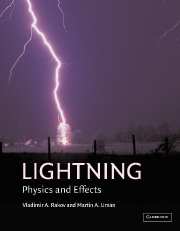Book contents
- Frontmatter
- Contents
- Preface
- 1 Introduction
- 2 Incidence of lightning
- 3 Electrical structure of lightning-producing clouds
- 4 Downward negative lightning discharges to ground
- 5 Positive and bipolar lightning discharges to ground
- 6 Upward lightning initiated by ground-based objects
- 7 Artificial initiation (triggering) of lightning by ground-based activity
- 8 Winter lightning in Japan
- 9 Cloud discharges
- 10 Lightning and airborne vehicles
- 11 Thunder
- 12 Modeling of lightning processes
- 13 The distant lightning electromagnetic environment: atmospherics, Schumann resonances, and whistlers
- 14 Lightning effects in the middle and upper atmosphere
- 15 Lightning effects on the chemistry of the atmosphere
- 16 Extraterrestrial lightning
- 17 Lightning locating systems
- 18 Deleterious effects of lightning and protective techniques
- 19 Lightning hazards to humans and animals
- 20 Ball lightning, bead lightning, and other unusual discharges
- Appendix: Books on lightning and related subjects
- Index
6 - Upward lightning initiated by ground-based objects
Published online by Cambridge University Press: 05 June 2013
- Frontmatter
- Contents
- Preface
- 1 Introduction
- 2 Incidence of lightning
- 3 Electrical structure of lightning-producing clouds
- 4 Downward negative lightning discharges to ground
- 5 Positive and bipolar lightning discharges to ground
- 6 Upward lightning initiated by ground-based objects
- 7 Artificial initiation (triggering) of lightning by ground-based activity
- 8 Winter lightning in Japan
- 9 Cloud discharges
- 10 Lightning and airborne vehicles
- 11 Thunder
- 12 Modeling of lightning processes
- 13 The distant lightning electromagnetic environment: atmospherics, Schumann resonances, and whistlers
- 14 Lightning effects in the middle and upper atmosphere
- 15 Lightning effects on the chemistry of the atmosphere
- 16 Extraterrestrial lightning
- 17 Lightning locating systems
- 18 Deleterious effects of lightning and protective techniques
- 19 Lightning hazards to humans and animals
- 20 Ball lightning, bead lightning, and other unusual discharges
- Appendix: Books on lightning and related subjects
- Index
Summary
It is realized that when making use of a tall structure, like the Empire State Building, the building acts as a great needle point, and may have a marked influence upon the character of the discharge.
K.B. McEachron (1939)Introduction
In this chapter, we consider lightning discharges initiated by leaders that originate from stationary grounded objects, usually tall towers, and propagate upward toward charged clouds overhead. Upward lightning, as opposed to “normal” downward lightning, would not occur if the object were not present and, hence, can be considered to be initiated by the object. As noted in subsection 2.9.1, objects with heights ranging from approximately 100 to 500 m experience both downward and upward flashes, the fraction of upward flashes increasing with the height of the object. The observed percentage of upward flashes for structures of different heights is given in Table 2.3. Structures having heights less than 100 m or so are usually assumed to be struck only by downward lightning, and structures with heights greater than 500 m or so are usually assumed to experience only upward flashes. In other words, upward flashes are usually neglected for structures lower than 100 m, and downward flashes are neglected for structures taller than 500 m. Apparently, all lightning discharges recorded by Davis and Standring (1947), who measured currents in the cables of kite balloons flying at a height of 600 m in England, were of the upward type.
Information
- Type
- Chapter
- Information
- LightningPhysics and Effects, pp. 241 - 264Publisher: Cambridge University PressPrint publication year: 2003
Accessibility standard: Unknown
Why this information is here
This section outlines the accessibility features of this content - including support for screen readers, full keyboard navigation and high-contrast display options. This may not be relevant for you.Accessibility Information
- 6
- Cited by
